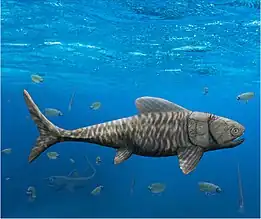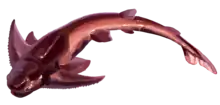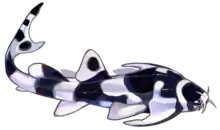| Amazichthys Temporal range: | |
|---|---|
 | |
| Holotype specimen AA.MEM.DS.8 (A and B), and paratype PIMUZ A/I 4773 (C, D) | |
 | |
| Life reconstruction | |
| Scientific classification | |
| Domain: | Eukaryota |
| Kingdom: | Animalia |
| Phylum: | Chordata |
| Class: | †Placodermi |
| Order: | †Arthrodira |
| Suborder: | †Brachythoraci |
| Family: | †Selenosteidae |
| Genus: | †Amazichthys Jobbins, 2022 |
| Species: | †A. trinajsticae |
| Binomial name | |
| †Amazichthys trinajsticae Jobbins, 2022 | |
Amazichthys is an extinct genus of selenosteid arthrodire from the Middle Famennian of the Late Devonian of the Anti-Atlas Mountains of Morocco. It contains a single species, Amazichthys trinajsticae. It is one of a few example of placoderm known from whole body shape, including cartilaginous axial and fin elements.[1]
Description
Amazichthys had a profile similar to that of fast-moving pelagic fishes, with lateral keels for stability, and a lunate caudal fin, suggesting it could reach and maintain high speed.[1] The holotype, AA.MEM.DS.8, is 89.7 cm (35.3 in) long.[1][2]
Etymology
Amazichthys trinajsticae was named after the North African ethnic group Amazigh (Berbers), and Australian palaeontologist Kate Trinajstic.[1]
Taxonomy
Amazichthys is part of Selenosteidae, a family inside the clade Aspinothoracidi, inside of Pachyosteomorphi, along with Dunkleosteoidea.
The cladogram shown here is based on Jobbins et al, 2022.[1]
| ||||||||||||||||||||||||||||||||||||||||||||||||||||||||||||||||||||||||||||||||||||||||||||||||||||||||||||||||||||||||||||||||||||||||||||||||||||||||||||||||
References
- 1 2 3 4 5 Jobbins, Melina; Rücklin, Martin; Ferrón, Humberto G.; Klug, Christian (2022). "A new selenosteid placoderm from the Late Devonian of the eastern Anti-Atlas (Morocco) with preserved body outline and its ecomorphology". Frontiers in Ecology and Evolution. 10. doi:10.3389/fevo.2022.969158. ISSN 2296-701X.
- ↑ Engelman, Russell K. (2023). "A Devonian Fish Tale: A New Method of Body Length Estimation Suggests Much Smaller Sizes for Dunkleosteus terrelli (Placodermi: Arthrodira)". Diversity. 15 (3). 318. doi:10.3390/d15030318.







